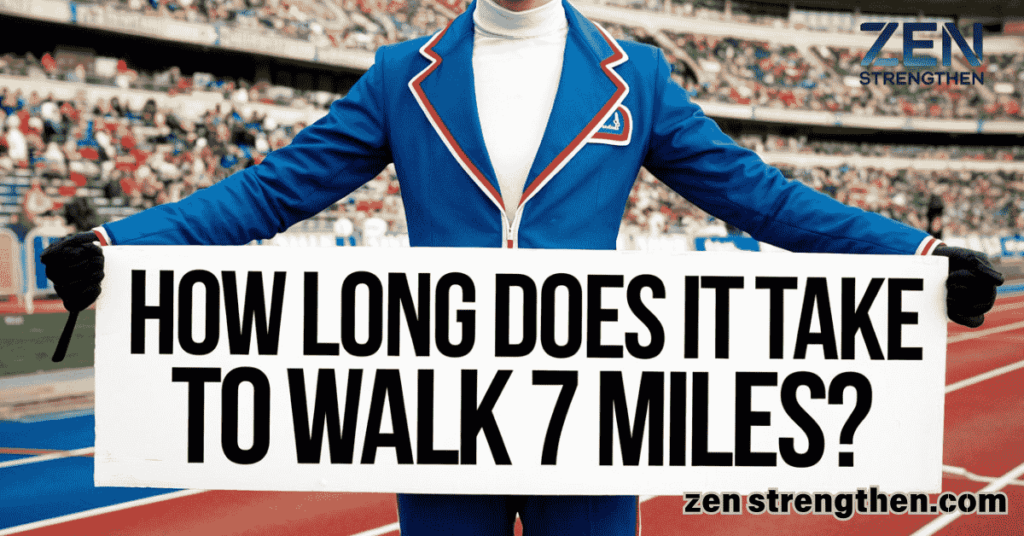Walking 7 miles might sound like a daunting task, but understanding the various factors that influence walking duration can make it easier to plan and achieve your long goal how to walk 7 miles
Whether you’re looking to fit a 7-mile walk into your daily routine or just curious about how long it takes, this guide provides an in-depth look at all the elements affecting the walking duration for 7 miles.
Factors Affecting Walking Time
Age
“Age” significantly impacts walking speed and endurance. Generally, younger individuals tend to walk faster due to better overall fitness levels and less joint stiffness. As we age, muscle strength and joint flexibility can decrease, which may slow walking pace. “walking pace“.
- Young Adults (20-30 years): Average walking speed is around 4.0 to 4.5 mph.
- Middle-Aged Adults (40-50 years): Average walking speed drops slightly to about 3.5 to 4.0 mph.
- Older Adults (60+ years): Average walking speed may be around 2.5 to 3.5 mph.
Gender
Gender differences also play a role in “average time to walk 7 miles.” Men generally have a faster walking pace compared to women, largely due to differences in muscle mass and cardiovascular fitness.
Gender differences also play a role in average time to walk 7 miles. Men generally have a faster walking pace compared to women, largely due to differences in muscle mass and cardiovascular fitness.
- Men: Typically walk at a speed of 4.0 to 4.5 mph.
- Women: Average walking speed is slightly lower, around 3.5 to 4.0 mph.
Height
Height affects stride length, which in turn influences walking speed. Taller individuals usually have a longer stride, allowing them to cover ground more quickly.
| Height (inches) | Average Stride Length (inches) | Walking Speed (mph) |
| 5’0″ (60) | 24 | 3.0 – 3.5 |
| 5’6″ (66) | 26 | 3.5 – 4.0 |
| 6’0″ (72) | 28 | 4.0 – 4.5 |
Stride/Step Length
Stride length directly impacts how fast you can walk. A longer stride usually means fewer steps are needed to cover 7 miles, which can translate to a shorter overall walking time.
To estimate your stride length:
- Measure the distance covered in 10 steps.
- Divide this distance by 10 to find your average stride length.
Fitness Level

Your overall fitness level is crucial when determining the 7-mile walk duration estimates. Well-conditioned individuals can maintain a brisk pace for longer periods, whereas those less fit might need to take more breaks.
- Fit Individuals: Walk at speeds between 4.0 and 4.5 mph.
- Moderately Fit Individuals: Walk at speeds between 3.5 and 4.0 mph.
- Less Fit Individuals: Walk at speeds between 2.5 and 3.5 mph.
Walking Speed
Walking speed is a primary factor in calculating the time required for 7-mile walk. Average walking speeds vary based on the factors discussed above, and adjusting your pace can help meet specific fitness or time goals.
Posture
Maintaining good posture while walking helps in efficient movement and can affect walking speed. Proper posture ensures less fatigue and better endurance, contributing to a more consistent pace throughout the walk.
Weather Conditions
Weather conditions can dramatically impact walking speed and comfort. For instance, walking in high heat or cold can slow you down as you might need to adjust your pace or take more breaks.
- Hot Weather: Dehydration and heat can slow you down. Drink water regularly and take breaks.
- Cold Weather: Wear appropriate layers to maintain body heat and prevent stiffness.
Location
The”Location” where you walk influences your pace. Walking on flat, even surfaces is easier and faster compared to rugged, uneven terrain. Elevation changes also affect walking speed; uphill walks will be slower, while downhill walks may. increase speed.
The location where you walk influences your pace. Walking on flat, even surfaces is easier and faster compared to rugged, uneven terrain. Elevation changes also affect walking speed; uphill walks will be slower, while downhill walks may increase speed.
Calculating Walking Metrics
How Many Steps Are There in a 7-Mile Walk?
The distance walked in 7 miles can be translated into steps using an average stride length. Here’s a rough estimate:
| Stride Length (inches) | Steps for 7 Miles |
| 24 | ~15,000 steps |
| 26 | ~14,000 steps |
| 28 | ~13,000 steps |
To calculate:
- Convert 7 miles into inches: 7 miles × 63,360 inches (per mile) = 443,520 inches.
- Divide by your stride length.
How Long Are 7 Miles in Minutes?
The 7-mile walk timing depends on your walking speed. Below is a table of estimated times based on different walking speeds:
| Walking Speed (mph) | Time Required for 7 Miles |
| 2.5 | 168 minutes (~2 hours 48 minutes) |
| 3.0 | 140 minutes (~2 hours 20 minutes) |
| 3.5 | 120 minutes (~2 hours) |
| 4.0 | 105 minutes (~1 hour 45 minutes) |
| 4.5 | 93 minutes (~1 hour 33 minutes) |
Calories Burned Walking 7 Miles
Walking burns calories, which varies by weight and speed. Here’s a rough estimate:
| Weight (lbs) | Calories Burned (approx.) |
| 125 | ~700 calories |
| 155 | ~900 calories |
| 185 | ~1,100 calories |
To calculate:
- Use a calorie burn calculator that factors in your weight and walking speed.
Walking 7 Miles on a Treadmill
Walking on a treadmill can differ from outdoor walking due to the lack of terrain variation and environmental factors. Generally, treadmill walking may be slightly faster due to the consistent surface.
- Indoor Treadmill: Time is similar to outdoor walking, but it may be easier to maintain a consistent pace.
Is 7 Miles a Lot to Walk?
Walking 7 miles is a considerable distance but is achievable with the right preparation. For context, it’s about a quarter of a marathon distance (26.2 miles). It can be a significant part of a fitness routine, depending on your fitness level and goals.
Benefits of Walking 7 Miles

Blood Pressure
Regular walking, including a 7-mile trek, can help reduce blood pressure levels. Engaging in this kind of exercise helps strengthen the heart and improve overall cardiovascular health.
Physical Fitness
Walking 7 miles contributes to overall physical fitness. It enhances cardiovascular health, strengthens muscles, and improves endurance. Incorporating such a walk into your routine can lead to substantial fitness gains.
Calories Burned
Regular walking burns calories, which supports weight management. Walking 7 miles can help you burn around 700 to 1,100 calories, depending on your weight and walking speed.
Bone Strength
Bone strength improves with weight-bearing exercises like walking. Regular walking helps maintain bone density and reduce the risk of osteoporosis.
Mental Health
Walking has significant benefits for mental health. A 7-mile walk can reduce stress, anxiety, and depression, contributing to improved mood and emotional well-being.
Focus
Walking helps enhance focus and cognitive function. Regular physical activity, including long walks, can improve concentration and mental clarity.
Mood Balance
Walking positively impacts mood balance. It stimulates the release of endorphins, which are natural mood lifters, helping to manage stress and improve overall emotional health.
Tips for Establishing a Walking Routine

Start with Small Steps
Begin with shorter distances and gradually increase to 7 miles. This approach helps build endurance and avoid injury.
Listening to Music
Listening to music can make walking more enjoyable and motivate you to maintain a steady pace. Create a playlist that keeps you energized.
Taking a Friend
Walking with a friend adds a social element and can enhance motivation. It also makes the walk more enjoyable and less monotonous.
Walking Barefoot
Walking barefoot can improve foot strength and balance, but it’s important to start on soft, clean surfaces to avoid injury.
Integrating Walking with Other Exercises
Combining walking with other forms of exercise, such as strength training or cycling, creates a balanced fitness routine. This integration helps improve overall fitness and prevents overuse injuries.
Sample Routine
- Monday: 7-mile walk
- Tuesday: Strength training
- Wednesday: 3-mile walk or rest
- Thursday: Cardio workout (cycling or swimming)
- Friday: 7-mile walk
- Saturday: Light activity (yoga or stretching)
- Sunday: Rest day
Final Thoughts
Understanding the 7-mile walking pace and the factors influencing it can help you set realistic goals and make the most out of your walking routine. With the right approach, walking 7 miles can be a rewarding and manageable activity that contributes to overall health and well-being.
FAQ,S
How Long Does It Take to Walk 7 Miles on Average?
The expected walking time for 7 miles varies based on your walking speed and fitness level. On average, it takes between 1 hour 45 minutes and 2 hours 50 minutes.
What Factors Affect Walking Time for 7 Miles?
Factors include age, gender, height, stride length, fitness level, walking speed, posture, weather conditions, and location.
Can I Estimate My Walking Time for 7 Miles?
Yes, by knowing your average walking speed for 7 miles, you can estimate the time required. Use the provided tables and formulas for a more accurate estimate.
Are There Resources to Track My Walking Progress?
Apps and devices like Fitbit, Garmin, and Apple Watch can track walking distance, pace, and calories burned, helping you monitor progress.
Is It Safe to Walk 7 Miles if I’m Not Very Fit?
Yes, but start gradually. Begin with shorter distances and increase as your fitness improves. Listen to your body and consult with a healthcare provider if needed.

Jhon Wick is a seasoned writer in the fitness niche, dedicated to sharing expert advice and the latest trends. With a passion for health and wellness, Jhon offers practical tips and inspiration to help readers achieve their fitness goals and stay motivated.







